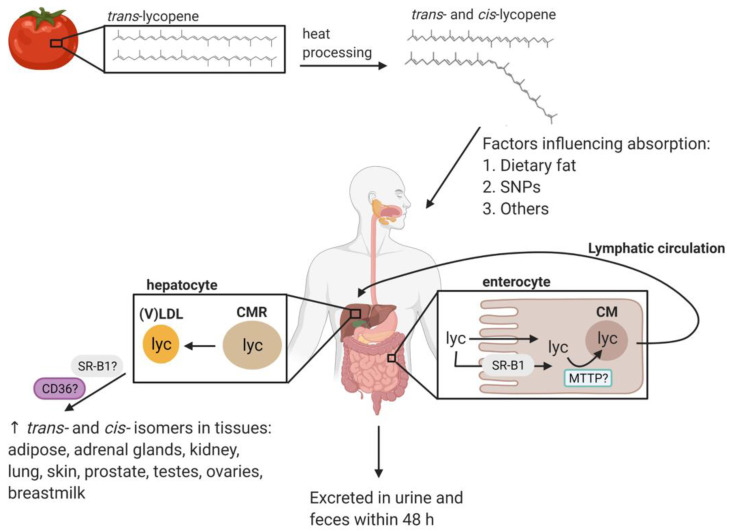Figure 2.
Lycopene (lyc) is present in plant (e.g., tomato) chloroplasts in microcrystalline structures formed by the linear, trans-isomer of lyc. Heat processing leads to increased lyc bioavailability as well as lyc isomerization, creating a mixture of trans- and cis-isomers found in cooked tomato products. The absorption of the fat-soluble carotenoid, lyc, is enhanced when consumed with a meal containing dietary fat (about 10 g dietary fat with cooked tomatoes or about 15 g dietary fat with uncooked tomatoes). Other factors such as single nucleotide polymorphisms (SNPs) are associated with lycopene absorption and metabolism although more definitive work is needed to increase our understanding of the interaction of SNP’s and lycopene metabolism in various tissues. In the intestines, trans- and cis-isomers of lyc may enter enterocytes either by passive diffusion or facilitated by scavenger receptor class B type 1 (SR-B1). Trans- and cis-lyc are incorporated into chylomicrons (CM), possibly facilitated by the activity of microsomal triglyceride transfer protein (MTTP), and transported to the liver via lymphatic circulation, during which some lyc may passively diffuse into tissues. In hepatocytes, contents of CM remnants (CMR) are repackaged into very low-density lipoproteins (VLDL) and distributed to the tissues via the bloodstream. Lipoproteins, especially low-density lipoprotein (LDL), interact with the tissues to transfer lyc, a process thought to be mediated in part by cell surface proteins SR-B1 and CD36. Although lyc preferentially accumulates within the liver, stores are also found in other tissues such as adipose, adrenal glands, kidneys, lungs, skin, prostate, testes, ovaries, and breastmilk. Dietary lyc is not efficiently absorbed. One study showed that an average of ~24% of a purified lyc dose was absorbed by human subjects [48].

